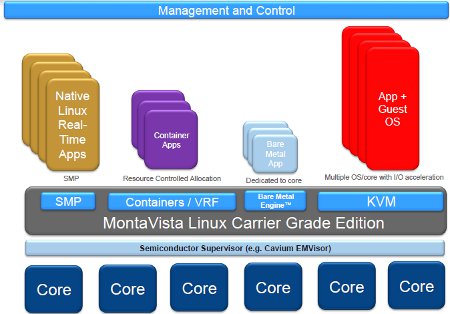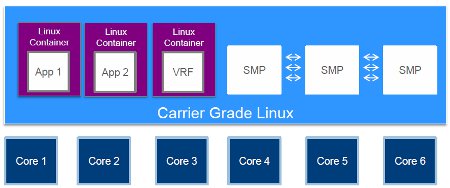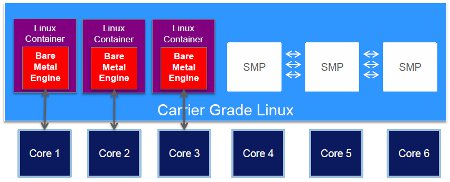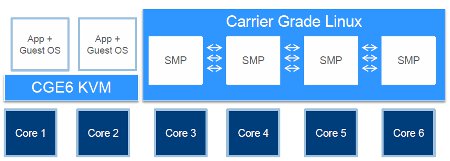MontaVista revs CGL Linux distro with virtualization and bare-metal engine
Oct 20, 2010 — by Eric Brown — from the LinuxDevices Archive — 23 viewsMontaVista Software released an updated Carrier Grade Linux (CGL) embedded distribution with a RTOS-like “Bare Metal Engine” option for maximizing performance on multicore designs. MontaVista Linux Carrier Grade Edition (CGE) 6.0 features a multicore resource management scheme for virtualization, adds support for Linux Containers, KVM, and EMVisor virtualization schemes, and upgrades OpenSAF support and power management features.
Only two days after Intel-owned Wind River Linux announced an updated Wind River Linux 4 commercial embedded distribution, Cavium Networks-owned rival MontaVista Software LLC announced its own major update. Whereas Wind River folds its Carrier Grade Linux (CGL) into the core Wind River Linux distribution, MontaVista separates MontaVista Linux Carrier Grade Edition (CGE) from the more consumer electronics-focused MontaVista Linux 6.
The CGE version was last updated to version 5.1, a year ago. CGE 5.1 improved support for 4G wireless networks, introduced OpenSAF support, and debuted new virtual routing and forwarding features.
Both the MontaVista and Wind River distributions are registered with the Linux Foundation for CGL 4.0 compliance for high-end networking applications. Both companies claim that the latest versions comply with CGL 5.0, which is due for final confirmation this fall (see farther below).
Multicore resource management
MontaVista Linux CGE 6.0 debuts a multicore resource management scheme that lets multiple embedded virtualization technologies run side-by-side within MontaVista Linux CGE. Whereas the software previously supported SMP virtualization for running native Linux real-time applications, version 6.0 provides an architecture to run multiple virtualization schemes, including SMP, simultaneously.
These include Linux Containers and KVM virtualization, both of which are provided in what MontaVista claims is the first multi-architecture support for the x86-focused technologies in a CGL distribution. There is also an ultra-fast, RTOS-like Bare Metal Engine (BME) implementation developed by MontaVista, as well as support for Cavium's new EMVisor virtualization technology.

Multiple virtualization schemes running simultaneously in MontaVista CGE 6.0
With multiple virtualization options and the new Bare Metal Engine, CGE 6.0 is even better equipped to replace RTOS (real-time operating system) based systems in high-end networking, such as 4G infrastructure, said MontaVista VP of Marketing Dan Cauchy in an interview with LinuxDevices last week.
Embedded virtualization frameworks tend to be flawed because they mimic the enterprise server world, which "is completely different," Cauchy added. RTOS vendors typically offer virtualization solutions that run Linux in a compartment to run higher-level functions. Yet with advances in Linux such as real-time functionality, "why use a proprietary OS at all?" asks Cauchy.
MontaVista founder and CTO Jim Ready offers further thoughts on embedded virtualization in a YouTube video posted farther below.
Linux Containers and KVM
Linux Containers offers the highest performing virtualization option available in CGE 6.0 except for the Bare Metal Engine. Similar to Linux-Vserver or OpenvzLinux, the open source Linux Containers (LXC) lets applications group and isolate a set of processes in a virtual "jail" by virtualizing and accounting the kernel resources.

Linux Containers in CGE 6.0
(Click to enlarge)
"You would use Containers when you need resource partitioning for security," said Cauchy. "You can also use it as a 'GPL jail' for code you want to be kept isolated. Each container gets its own file system, address space, and mapped I/O, so you get really good performance."
BME: Pedal to the bare metal
Linux Containers underlies what may be the biggest enhancement to MontaVista Linux CGE 6.0 — the new Bare Metal Engine (BME). BME is defined by MontaVista as a "lightweight, configurable run-time environment that delivers RTOS performance inside a Linux environment."
Designed for packet processing and deep packet inspection networking applications, the technology lets users create a dedicated environment to run Linux processes using Linux Containers, providing bare-metal execution and performance all in Linux.

Bare Metal Engine on a multi-core system
(Click to enlarge)
BME provides multiple configurations, letting users choose their own trade-off level between services and performance, says MontaVista. BME is said to use real-time scheduling for prioritized execution, and supports ultra-low latency.
The technology, which is offered as an optional run-time, is particularly suited to gaining the most efficiency from multicore processors, says the company. BME makes use of 99.999 percent of core processes, said MontaVista's Cauchy.
"This will blow away any RTOS," said Cauchy. "We speed up execution by doing things like vector interrupts, I/O memory mapping, and turning off timers." BME is initially optimized for running on Cavium Octeon and Freescale QorIQ processors, he added.
KVM support goes multi-architecture
The new implementation of the increasingly popular KVM (Kernel-based Virtual Machine), meanwhile provides hard-resource partitioning, and is designed for more robust security requirements. KVM tends to run more slowly, however, than Linux Containers, says MontaVista.

KVM on a multi-core system
(Click to enlarge)
Cavium EMVisor support
In the first example we've seen of MontaVista showing signs of favoritism to its owner, Cavium Networks, CGE 6.0 adds support for Cavium's new EMVisor virtualization technology for systems running the company's MIPS-based Octeon multicore processors.
EMVisor (Embedded Multicore Virtualization) abstracts the underlying hardware, allowing developers to create virtual system-on-chips (SoCs) by grouping processor cores and I/O to quickly set up an optimized system, says MontaVista.
The EMVisor name was trademarked at the end of August, and there appears to be no more public information on the technology. Cauchy did not mention EMVisor in our discussion.
OpenSAF, power management, and more
In addition to its new virtualization and multicore functionality, MontaVista Linux CGE 6.0 offers the following enhancements:
- OpenSAF 4.0 support — OpenSAF offers standardized high availability functionality consistent with Service Availability Forum (SAF) specifications. MontaVista made a big deal of adding OpenSAF 3.0 support in CGE 5.1, but Cauchy admits that few customers have signed on, waiting for further refinements now available with OpenSAF 4.0.
Previous versions of CGE have already achieved "six 9's" availability (99.9999 percent or less than 31.5 seconds of downtime per year), says MontaVista. OpenSAF 4.0 standardizes and extends this support, offering updated OpenHPI and TIPC protocols, says the company.
- Virtual Routing and Forwarding (VRF) — MontaVista touted its VRF functionality as being the first such Linux implementation when it debuted in CGE 5.1 — but apparently it was fairly bleeding-edge. The new version has been completely rewritten, said Cauchy.
VRF enables separating of routing and forwarding domains, enabling emulation of three or four physical routers on a single multicore blade, while still providing separate IP for security, says MontaVista. This is said to enable the use of more affordable COTS hardware for secure wireless networks. The new version is enabled via the new Linux Containers technology for better isolation, says the company.
- Power management — CGE 6.0 incorporates some of the Linux kernel's newer power management features. (CGE 6.0 is based on kernel 2.6.32.) These include P-States and C-States for x86 platforms, Power Throttle for MIPS64, and SYSCLK, NAP, DOZE, and SLEEP on Power architecture systems, says the company. According to Cauchy, the dynamic throttling features in particular should help CGE 6.0 provide an average of 10 to 15 percent power savings over version 5.1, with as much as 60 percent savings in some cases.
- Enhanced serviceability — New serviceability features include run-time application patching (RTAP) and the field safe application debugger (FSAD). RTAP lets users apply a binary patch to running system. "It makes it easy to log in to collect logs," said Cauchy. "At no point in time do you need to freeze a task."
FSAD, meanwhile, offers non-intrusive field debugging with minimal impact, he said. Earlier serviceability features such as the "flight recorder" technology and microstate accounting have been further improved in CGE 6.0, says MontaVista.
- CGL 5.0 — As noted above, CGE 6.0 is claimed to support in advance the next-generation CGL 5.0, which is due this year. Cauchy is chairman of the Linux Foundation's Carrier Grade Linux (CGL) working group, and would not comment on CGL 5.0 enhancements, but he said it could be published as soon as next month. MontaVista Linux CGE is the only carrier grade Linux to be compliant with CGL 4.0, CGL 5.0 (draft), LSB, and IPv6 certifications, claims the company.
Testimonials
Stated Greg Lavender, VP of Foundation Engineering at Cisco. "MontaVista's innovative approach to virtualization sets a new standard for next generation network equipment on multicore architectures. The addition of advanced power management in a carrier grade Linux helps further Cisco's goal of environmental sustainability using energy-wise core technology."
Stated Venkataraman Prasannan, General Manager, ATCA, RadiSys, "The high performance and availability capabilities provided in MontaVista Linux CGE 6.0 will enable RadiSys customers to rapidly develop new 4G applications that meet their unique price/performance goals."
Stated Chris Rommel, senior analyst, at VDC Research, "The requirement for virtualization in an embedded environment is far different than the server IT market. MontaVista's approach to virtualization and resource partitioning in CGE 6.0 with containers, KVM, and Bare Metal Engine offers customers alternatives to develop the solutions that best meet their requirements."
MontaVista founder and CTO Jim Ready discussing virtualization in the embedded world on YouTube
(Click to play)
MontaVista Linux Carrier Grade Edition (CGE) 6.0 is available now, says MontaVista, which did not list pricing. More information, including detailed spec lists, may be found here.
This article was originally published on LinuxDevices.com and has been donated to the open source community by QuinStreet Inc. Please visit LinuxToday.com for up-to-date news and articles about Linux and open source.